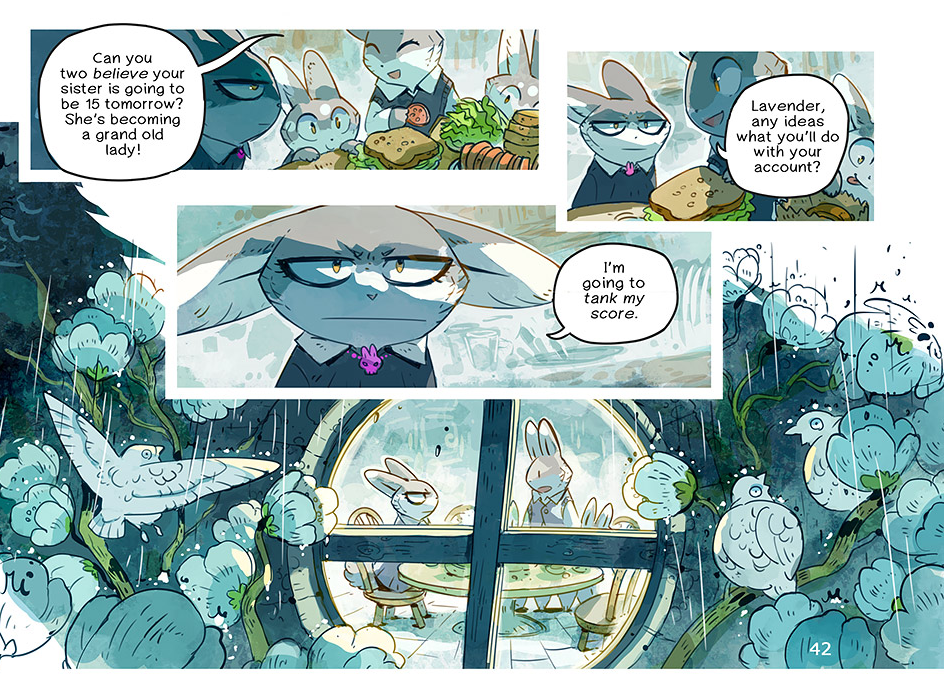Courtesy of Brian Niemeier, I read a great short graphic novel (available free and digitally) by Minna Sundberg this week regarding control, social credit, and human conditioning… through rabbits:
https://www.hummingfluff.com/lovelypeoplecomic.html
I think this is a great comic for a few of reasons.
First, the subject matter is on-point and topical. We in the west tend to look over at China and their social credit system (sesame credit) and think we are much better when it comes to thought control, and in a way, we are. That is to say, the west is good at controlling thought in more opaque manner. We have a social credit system, it is just not overt, but takes place through megacorporate data records and countless complex algorithmic sortings of that data.
It makes sense, therefore, that the first thing the comic presents us with is “Transparency day” – the day when the end users finally get to see how their actions are affecting their (formerly) secret social credit score.
The subject matter is also on point because it explicitly goes to the bible and Christianity as the social “no-no,” which is something most of us experience but are told isn’t real. This is also important because the resolution of the conflict of the story is explicitly Christian and much different than if a secularist were to write the same story. Read it, and you will see for yourself.
Second, the comic is really well executed in the story department. It begins with a classic form of direct exposition (telling the reader directly what he needs to know about the speculative setting or conflict), but rather than doing it the Stan Lee way, in captions, it is done through a voice broadcasting the same information, disguising it in the visual format in a small way. Within one page, we understand everything we need to for the beginning of the story’s conflict.

Minna then transitions directly to the three main characters interacting and presenting the main (initial) goal of the plot – to survive or master the social credit system. To that end the three main characters represent three main attitudes toward the system:
Peony, who masters the system through Machiavellian self-interest, seeking the worldly rewards that come from acting the way the “world council” wants her to act without really believing in it.
Marigold, the protagonist, who wants to follow Peony’s lead but is conflicted over her principles and her religion. Reading her bible begins to negatively impact her score, which presents a tragic temptation – to abandon one’s faith for worldly rewards.
Peppermint, initially a “true believer” who touts the social credit system as a good, only to be quickly disillusioned by the consequences of it.
The plot really kicks into gear in the third act, setting up the downfall of all three primary characters through tragic means, yet the plot resolves as a medieval comedy – with a happy, morally just outcome.
Marigold abandons her faith, only to realize she can return to it and be forgiven. Peppermint realizes that her own obsequiousness will not save her from the wrath of the world. Peony snaps, connot maintain her facade, and has all the worldly things that she values taken away from her.
All these things happen in tandem and are very well balanced.
Third, the art is excellent. Drawn and painted in what I assume is a digital space, the colors are vivid and really pop on a screen. They have the appearance of highly saturated water color, like something Bill Waterson would do, only brighter.

The cartoonish bunnies are really cute and most of their environments are pleasant and whimsical, which gives the whole piece a kind of levity that is needed considering how serious the subject matter is. A more “classic comic” approach to illustration would have made things far too dour. It’s also a reminder that a dystopia, in Logan’s Run fashion, is not always a filthy wasteland, but is ugly because of what it does to people.
So do give it a read, along with Finna’s testimony afterward, and think about supporting the artist.
I am an independent writer and musician working in a variety of genres. You can find some of my books below, including my creativity book for establishing a great creative process. If you want a more Christian take on horror, please do consider picking up Eyes in the Walls.





If you like the art, you should check Minna’s “main” comic, the almost-a-decade-running, post-apocalyptic “Stand Still Stay Silent” (sssscomic.com). Her drawing style changes a lot during all those years, but pretty much every page from #120 to #780 is a legitimate work of art that I wouldn’t hesitate to frame and put on my walls. As for the comic itself, it’s like a Nordic saga of old: long, slow and brooding. But that’s not necessarily a bad thing. :)
This was a really good comic, and I’m glad I read it. It’s not just that the art is beautiful, but it perfectly heightens the underlying themes. Props to Sundberg for being both chillingly accurate and wonderfully hopeful.
It’s a little on-the-nose where it needs to be, and delightfully subtle at others; pay close attention to the characters’ body language and facial expressions to see what I mean. The complete package. I will be keeping an eye on her other work.